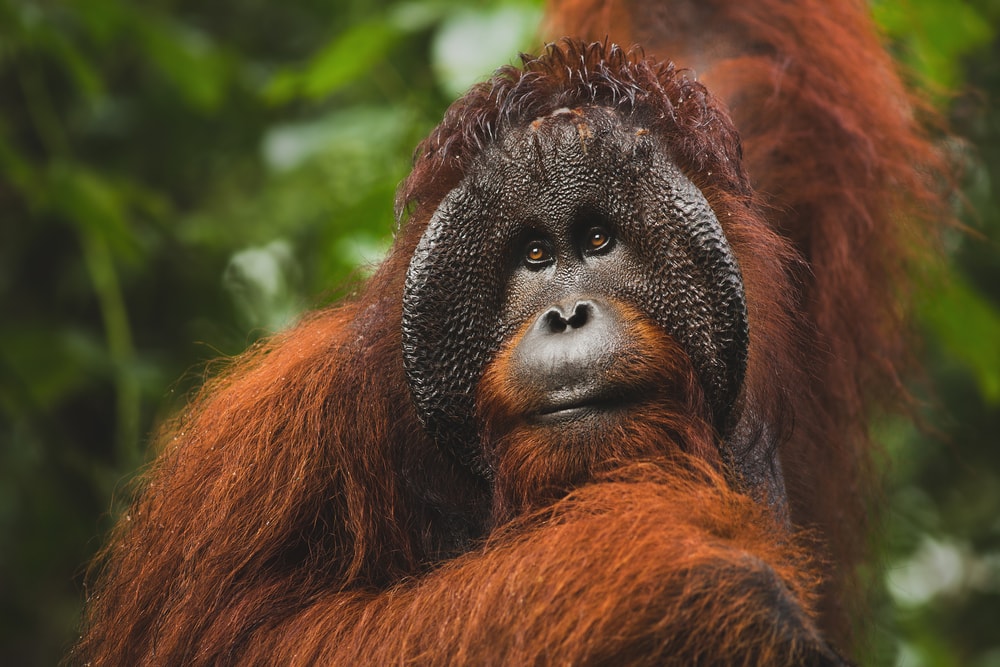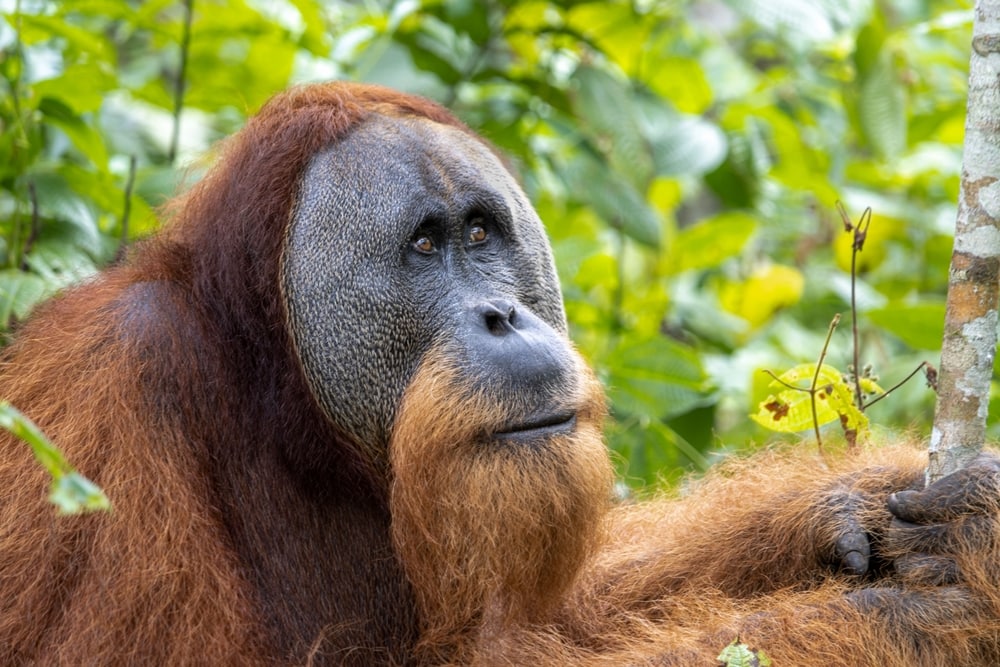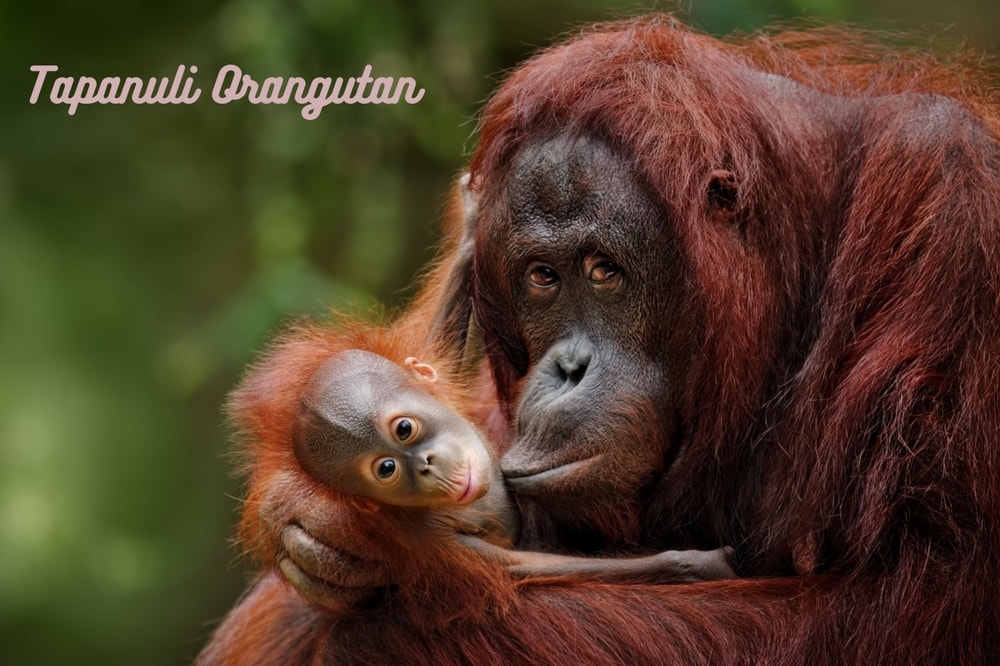Outforia Quicktake: Key Takeaways
- Tapanuli orangutan is the most recently discovered orangutan species, found on the island of Sumatra in Indonesia.
- The species is critically endangered with fewer than 800 individuals remaining.
- Tapanuli orangutans are highly intelligent, and their arm span is about 6.5 feet (2 meters) for swinging from tree to tree.
- They have a slow reproduction process and face threats such as habitat loss, poaching, and illegal pet trade.
- Orangutans are keystone species playing a crucial role in seed dispersal and maintaining the biodiversity of their ecosystems.
The Tapanuli orangutan is the most recently discovered orangutan species found on the island of Sumatra in Indonesia.
There were previously only two known orangutan species: the Bornean orangutan and the Sumatran orangutan.
The Tapanuli orangutan is the most endangered of the three. Although the presence of the Tapanuli orangutan population was already known, a study conducted in 2017 defined it as a separate species.
What is an Orangutan?

An orangutan is a type of great ape that inhabits the islands of Borneo and Sumatra. Borneo belongs to three different countries, including Indonesia, Malaysia, and Brunei. Sumatra is an island located in Indonesia. The Indian Ocean and several other seas encircle it.
All orangutan species are classified as critically endangered by the International Union for Conservation of Nature (IUCN) Red List. Populations are decreasing, mainly due to human activities impacting their habitats.
There are three types of orangutan species recognized, which include:
- Sumatran orangutan (Pongo abelii)
- Bornean orangutan (Pongo pygmaeus)
- Tapanuli orangutan (Pongo tapanuliensis)
The Tapanuli orangutan is the newest member of the orangutan family. Although its population was first discovered in 1939, it wasn’t until 2017 that it was defined as a new species.
Orangutans are easily recognizable by their large bodies covered in long, reddish-orange fur.
You May Also Like: How Long Do Monkeys Live? Exploring The Intriguing Lives Of Monkeys And Their Lifespans
Classification of the Tapanuli Orangutan

Orangutans belong to the family Hominidae, which also includes humans, gorillas, and chimpanzees. Orangutans fall under the subfamily Ponginae and the genus Pongo.
Orangutans are the only living species in this subfamily, which used to include other Eurasian apes.
There are two other extinct species that belong to the genus Pongo. Those extinct species include the Vietnamese orangutan (Pongo hooijeri) and the Chinese orangutan (Pongo weidenreichi).
The Tapanuli orangutan was officially defined as a separate orangutan species after a genetic study conducted in 2017. It was previously thought that Tapanuli orangutans were an isolated population of Sumatran orangutans.
There were a few distinct characteristics, including skull size and face shape, that raised debate over its relation to the other two orangutan species.
Through genetic testing, scientists and researchers discovered that Tapanuli orangutans were in fact an entirely different species. It was also determined that Tapanuli orangutans were more closely related to Bornean orangutans than Sumatran orangutans.
Appearance and Size

Orangutans are large apes but typically smaller than gorillas. Like many ape and monkey species, males are larger than females.
Adult male Tapanuli orangutans are usually about 5 feet (1.5 m) tall and average about 165 pounds (75 kg). Females are usually 12 inches (30.4 cm) shorter and weigh around 80 pounds (36 kg).
Like all orangutan species, Tapanuli orangutans have long, reddish-orange fur covering their bodies. Their faces are covered with short blonde hair. They also have a beard and mustache!
Orangutans have long arms, which help them swing from tree to tree in the forest canopy. This action is called brachiation. They use their hands and feet to grasp branches.
One of the features that helped scientists distinguish the Tapanuli orangutan from other species was its skull size. Tapanuli orangutans have smaller skulls compared to Bornean and Sumatran orangutans.
Geographic Distribution and Range

Tapanuli orangutans can only be found in the Batang Toru Ecosystem in the South Tapanuli Regency of North Sumatra, Indonesia.
Their historical range is believed to be in the lowlands of this region. This species now lives in areas outside of its historical range as a result of human activity. They’re mainly found in the submontane highland forests about 2,789 ft (850 m) above sea level.
The entire Batang Toru Ecosystem takes up about 579 square miles (1,500 sq km). The current range of Tapanuli orangutans makes up about 475 square miles (712 sq km) of the ecosystem.
It’s unknown exactly how long Tapanuli orangutans have been isolated from other orangutan populations. It’s estimated that this species may have become isolated more than 10,000 years ago.
Habitat and Lifestyle

Tapanuli orangutans spend most of their lives in the forest canopy. They’re almost entirely arboreal. Adult males may travel to the ground if necessary, but this is uncommon. Living in the canopy protects them from potential predators on the forest floor.
These orangutans use their long arms to travel between trees and reach branches with food. They create nesting sites with vegetation to rest throughout the day and at night.
Tapanuli orangutans are mostly solitary creatures. They don’t live in colonies or large groups like many other primates. Small, temporary groups may form during feeding. The only time Tapanuli orangutans are found together is when a mother is raising her young or during mating.
Since Tapanuli orangutans are solitary, they don’t have a social hierarchy system. However, males are separated into two groups characterized by their development.
Fully developed males are known as flanged males. Unflanged males are individuals who have not reached the final stage in development. More research is needed to fully understand how unflanged males develop into flanged males.
Diet and Behaviors

Fruit makes up the majority of the Tapanuli orangutan’s diet. They’ve been observed eating fruits that other orangutan species may not consume, such as agathis fruits.
They also eat other parts of vegetation, such as leaves, flower buds, and tree bark. Some of their favorite foods include figs, mangos, and wild durian.
Orangutans are known for being incredibly intelligent creatures.
They’ve been observed using special techniques to access food and complete other tasks. They may use branches and limbs to reach other branches with food farther away. They’ve also been observed using tree limbs as toothpicks and leafy branches for shade.
Orangutans can learn from mimicking behaviors they’ve seen in other individuals—even humans!
A 2009 study observed gestural communication in orangutans in zoos. The results of the study determined that the orangutans observed exhibited at least 64 different intentional gestures.
In 2019, scientists from the University of Exeter conducted a more in-depth study of wild orangutan communication styles. The scientists focused on observing communication styles between mothers, infants, and a pair of siblings.
It was determined that at least 858 vocal signals and 441 gestures were used. These studies provide insight into just how advanced orangutans’ cognitive abilities are.
Reproduction and Life Cycle

The reproduction process of orangutans is extremely slow. Females don’t become sexually mature until about 10–15 years of age. Juvenile Tapanuli orangutans stay with their mothers for at least 8–9 years before becoming independent.
Females usually give birth to one baby at a time, or sometimes two if they have twins. Mothers raise their offspring alone. Males don’t play a role in raising the offspring.
Since Tapanuli orangutans are solitary, mothers have had their hands full for almost a decade caring for their young. Because of this, mothers will not reproduce again until their children become independent.
This long reproduction process is one of the reasons that population numbers are so low. The reproduction rate is too slow to combat the threats that these great apes face.
You May Also Like: What Do Monkeys Eat? Discover The Surprising Truth Behind Their Omnivorous Diets
Population and Conservation Status

Although the discovery of the Tapanuli orangutan was exciting news, its population size is very concerning. It’s the most endangered species of all orangutans and great apes. With fewer than 800 individuals left in the wild, the Tapanuli orangutan is at risk of extinction.
Due to several threats that Tapanuli orangutans face, scientists believe that 1.2% of the current population will be lost over the next decade.
According to the IUCN Red List, the Tapanuli orangutan population is still decreasing.
The main threats specific to the Tapanuli orangutan species include:
- Clearing of forests for palm oil plantations and urban development
- Illegal hunting and killing
- Illegal pet trade in baby orangutans
- Infrastructure development
The Sumatran Orangutan Conservation Programme is a conservation organization that has worked to protect the lands of the Batang Toru Ecosystem.
It has helped establish some protected lands within the region. However, several parts of the Tapanuli orangutan range remain unprotected.
Tapanuli Orangutan Threats and Predators

One of the biggest current threats to the Tapanuli orangutan population is a $1.6 billion hydroelectric dam project that was first introduced in 2012.
Construction on the dam began in 2017, prior to the recognition of the Tapanuli orangutan species. The project was halted in 2019 but is believed to have resumed since then.
The dam would be located in the Batang Toru Ecosystem along the Batang Toru River. Although the dam was previously needed to meet energy demands, other projects have made its construction unnecessary.
Not only would the dam have a negative impact on the Tapanuli orangutan population, but it would also affect the critically endangered Sumatran orangutan, Sumatran tiger, and pangolin. The dam would cut right through the Tapanuli orangutan range and isolate the population even more.
Other infrastructure development projects also harm the species. Building roads and power lines in the Batang Toru Ecosystem can isolate, injure, and cause the deaths of Tapanuli orangutans.
Since Tapanuli orangutans are almost completely arboreal, dividing the forest can reduce their range even more.
Illegal capture is a threat to young Tapanuli orangutans. Poachers enter the region to steal baby Tapanuli orangutans, often killing the mother in the process.
The babies are then sold in the illegal pet trade. If a captured baby isn’t sold, captors will often kill it when it gets too big for sale. Babies can also die from malnutrition because captors usually don’t feed them the diet they would have in the wild.
What is the Ecological Role of Tapanuli Orangutans?

Orangutans are keystone species because they play a vital role in the ecosystems they live in. Seed dispersal is one of their most important contributions to their ecosystems. Orangutans eat hundreds of types of fruit.
Due to their diet, orangutans spread seeds throughout their range. Seed dispersal is critical to plant survival and biodiversity. It not only helps spread plants but also provides more food for species that feed on them.
Monkeys in the area also eat fruit, but Tapanuli orangutans snack on fruits and seeds that are unwanted or too large for small monkeys.
What’s the Difference Between the Tapanuli Orangutan vs Bornean and Sumatran Orangutans?

All three orangutan species can be difficult to distinguish just by appearance. This is one of the reasons Tapanuli orangutans were mistakenly recognized as Sumatran orangutans for decades. However, there are several differences between Tapanuli, Bornean, and Sumatran orangutans.
Some of these differences include:
- Taxonomically, Bornean and Tapanuli orangutans are more closely related to each other than Sumatran orangutans.
- Tapanuli orangutans have smaller skulls than Bornean and Sumatran orangutans
- Tapanuli orangutans have blonde hair on their faces, while Bornean and Sumatran orangutans don’t.
- Male Tapanuli orangutans have different calls than male Bornean and Sumatran orangutans.
- Bornean orangutans are more likely to travel down to the forest floor than Tapanuli and Sumatran orangutans.
Sumatran and Bornean orangutans are also more abundant than Tapanuli orangutans. However, all orangutan species are threatened with extinction.
Bornean orangutans have the largest population size, with about 104,700 individuals. There are about 13,846 Sumatran orangutans. Less than 800 Tapanuli orangutans are known to exist in their isolated range.
Fun Facts
Orangutans have very long arms.

Orangutans have very long arms, which come in handy when swinging from tree to tree. Their arm span is about 6.5 feet (2 meters), which is longer than their total body length!
Orangutans are also very strong. Their strength is about seven times greater than the average strength of a human.
Orangutans could go extinct in 50 years.

Due to rapid declines in population, orangutans have become increasingly at risk of extinction. Some researchers believe that the world’s orangutan population could go extinct in 50 years or less.
Loss of habitat, poaching, and the illegal pet trade contribute to the loss of up to 3,000 orangutans per year on average.
Orangutans have a similar life cycle to humans.

Female orangutans don’t become sexually mature until at least 10 years of age. Some individuals may not mature until around 15 years of age.
The gestation period of orangutans is around the same length as that of humans. Orangutans have about an 8 1/2-month gestation period, while humans have a 9-month gestation period. Orangutans can also have a long lifespan. They can live up to 60 years in captivity.
Something that makes orangutans even more similar to humans is their DNA. According to researchers, about 97% of their DNA is shared with humans!
You May Also Like: Wild Monkeys In Florida: All About Them And How They Got There
Tapanuli Orangutan FAQ

Why are orangutans so rare?
Orangutans are extremely rare primates because of their slow reproduction process. It takes at least a decade for females to sexually mature. Furthermore, mothers only give birth to one, sometimes two, infants at a time every 8–9 years.
Considering the average 40-year lifespan of orangutans in the wild, this means that females are only capable of producing a minimum of four offspring in their lifetime.
Human-related activities that are detrimental to their habitat and well-being also have an impact on their rarity.
How intelligent are orangutans?
Orangutans are one of the most intelligent great ape species. They’re capable of solving problems and learning new behaviors through mimicking.
Other abilities that have been discovered through research include the ability to be deceptive, display empathy, and act with intention.
An orangutan named Chantek, who was raised in captivity, learned American sign language. He was also taught other human tasks, such as using a toilet.
Are orangutans aggressive?
Orangutans aren’t known to be naturally aggressive. Males may become aggressive toward each other when they’re competing for a mate. However, fighting is uncommon, as one male usually backs down before the conflict turns violent.
Like many wild and domesticated animals, orangutans can develop aggressive behavior if they’re treated poorly in captivity.










